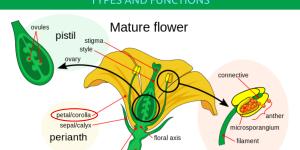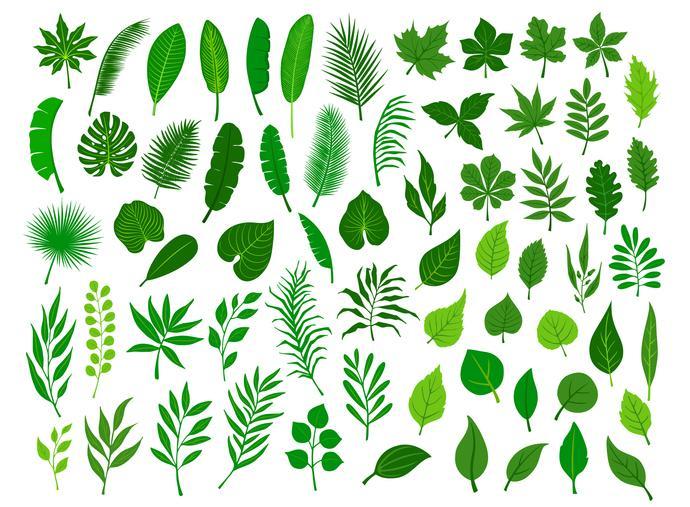Parts of a Leaf Diagram and Functions


Although they are one of the structures most associated with the type of organism, not all plants have leaves. Most do and many have leaves which may not look like it. For example, a blade of grass is a type of leaf. Even mosses have leaves, although they have a much more simple structure and are not considered true leaves. Despite so many plants having leaves, there is such an incredible range of diversity in how they appear. Their structures vary wildly for various reasons, not all of which are known to botanists. What we do know is just how important leaves our for plants and that without them, nature would look very different.
At thedailyECO, we learn about leaf structure and anatomy by providing a parts of a leaf diagram and functions. By knowing what each part of a leaf does, we can see how they affect the enture organism.
Parts of a leaf and their functions
True leaves are the leaves of a vascular plant which are able to carry out photosynthesis. Our parts of a leaf diagram depicts the structure and anatomy of a true leaf. These contain the following:
Lamina
Also known as the leaf blade, the lamina is the flat part of the leaf which is most visible. It is for this reason we think of grass leaves as blades, although they are just a differently shaped leaf structure. Generally speaking, laminae are either flat and wide or long and thing.
Leaf laminae have two sides, a topside (adaxial side) and an underside (abaxial side). The former tends to be smoother and shinier, although this varies. The underside tends to have more exposed veins or nerves of the leaf. For this reason, there may be different shapes or patterns through which the various saps and fluids pass through the vascularized leaf. This is one reason the leaves of non-vascular plants such as bryophytes look so different.
The outer margin of the lamina is one of the most characteristic parts of a leaf. This can be more or less simple, with some types of compound leaves looking almost as if they are separate parts. The apex of the lamina is the end furthest from the leaf's stem. Depending on the shape of the leaves, we can easily recognize the different species of plants and trees.
Petiole
The petiole is what joins the leaf blade to the stem of the plant. It is a slender, deep green structure whose function is to supply sap to and from the leaf and to give the leaf blade a firm hold against the elements.
Sheath
At the base of the petiole is the sheath. This is the point at which the petiole widens to join and attach to the stem. It is therefore the point at which the leaf begins to grow from the stem of the plant.
Stipule
Finally there are the stipules. These are small structures that grow sideways from the petiole or base of the leaf. Not all plants have stipules and they can have very different shapes. Their function is always to protect the young shoots and leaves, which is why some of them fall off when the leaf matures.
We have two diagrams of plant leaves to help you see what parts of the leaf anatomy are what. One is in the title of the article and the other is below.

Functions of parts of a leaf
Of all the functions of a leaf, photosynthesis is the one most important to both the individual plant and the ecosystems in which they live. It is also the most important for the survival of all species on Earth, including our own. With this in mind, the main functions of plant leaves and their parts are:
- Photosynthesis: thanks to the chloroplasts which give the plant its green color due to the chlorophyll they contain, the plant is capable of forming sugars from the energy received from sunlight and the CO2 that the plant absorbs. The function of photosynthesis is vital not only for the plant, but also for the conformation of life on our planet. During the evolution of plants, photosynthesis allowed the Earth's atmosphere to become rich in oxygen, the ozone layer to be created and life on land to be possible. The plant can be nourished thanks to this process in which the plant uses the solar energy captured by the leaves to transform the raw sap that reaches them into elaborated or enriched sap, which is loaded with nutrients and is distributed to the parts of the plant.
- Respiration: another function of the leaves is respiration for the plant itself. The plant absorbs the oxygen present in the atmosphere, expelling carbon dioxide in return. This respiration occurs through the stomata on the leaf.
- Transpiration: finally, the leaves also fulfill the function of transpiration. In addition to respiration, the stomata can open to release water for it to evaporate, in doing so eliminating excess water and allowing the plant to regulate water and heat. In addition, there are theories that maintain that this evaporation helps to create a negative pressure in the plant's ducts, which enables the circulation of the raw sap from the roots. This makes it easier for even large trees to carry it to their high branches without wasting energy.
We have referenced the stomata of plants, but these are not necessarily just a part of the plant leaf. They can also be found on stems and other plants organs. However, stomata do usually appear on the abaxial side of the leaf. They are even present in many non-vascular plants. Learn more about their parts and function with our related article on what are the stomata of plants?

Types of leaves
Now we have looked at the different parts of leaves and their functions, we can have a better idea of how they work by looking at the various types of leaves we can find in nature. Theses leaves are specifically adapted for the plants needs. For example, a wider leaf might be required for plants which cannot get much sun. Others have needle-shaped leaves which are designed to store more water, especially important for evergreen plants.
With this context in mind, we can have an idea of the different types of leaves we can find:
- Compound and simple leaves: when a blade is born from each petiole, the leaf is simple. This does not mean the simple leaf has only one shape, but their blade is only one entity. If several limbs grow from a single petiole, it is a compound leaf. These can be combined, unifoliate, pinnate or palmate, depending on the number of leaflets (or pinnate) if the leaflets all emerge from a single axis.
- Veins of leaves: leaves can also be these can be parallelinerved, penninerved, palminerved, dichotomous or uninerved, depending on the number of veins and how they are structured on the lamina. You can see many of these variations in the diagram above.
- Shape of the leaf blade: these can be sagittate (arrow-shaped), oval, orbicular, spatulate, acicular, scaly, heart-shaped, rhomboid, lanceolate, linear, ribbon-shaped, palmate or kidney-shaped. These are also depicted in the diagram above.
- Other types of leaves: there are many other classifications, such as according to the shape of the blade edge, according to the petiole or according to the arrangement of the leaves on the stem, among others.
While most vascular plants have leaves, not all of them do. We can see this with cacti which have spines instead of leaves. Learn more about the structure of these and similar plants with our article on xerophyte plants with examples.

If you want to read similar articles to Parts of a Leaf Diagram and Functions, we recommend you visit our Biology category.







